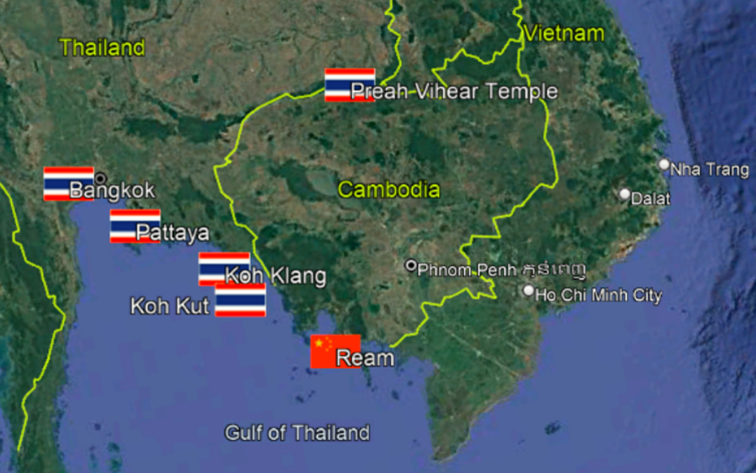Ceasefire Threatened as Cambodia Lays Mines Across Thai Border
A ceasefire agreed between Cambodia and Thailand in August is in jeopardy after Thai soldiers were wounded by mines in an area of Thai territory occupied by Cambodian squatters.
The ceasefire agreed between the two countries called for a withdrawal of heavy weapons from the areas of dispute, but did not resolve discrepancies between the de facto and the de jure border in a number of areas. The 13-point agreement was signed under the umbrella of the ASEAN organization, with both China and the United States attending as observers. Malaysia volunteered to help resolve the outstanding issues.
The principal area of dispute remains the ownership of the Preah Vihear temple complex in Si Sa Ket Province, and in border areas to the west in Sa Kaeo Province. Here and elsewhere, Khmer settlements have encroached onto Thai land, and squatters have been in place for so long that the border has for practical purposes shifted.
The incidents which have threatened the ceasefire have been caused by seven separate incidents in which Thai soldiers have lost limbs and been wounded by mines on the Thai side of the border. Thailand has presented evidence that the mines are of recent Russian manufacture, and have been planted since the ceasefire came into force. Thai public opinion has been outraged by these incidents. To avoid any criticism, Thai clearance operations are continuing on the Thai side of the border, but only in the presence of ASEAN military observers from Malaysia, Indonesia and the Philippines - to forestall any Cambodian criticisms of encroachment.

Preah Vihear, Kon Klang and Koh Kut - areas of border tension between Cambodia and Thailand (Google Earth/CNES Airbus CJRC)
In the summer and at the height of the border dispute, a number of Thai politicians and military commanders were censured for having adopted an over-conciliatory approach, sometimes allegedly in return for bribes. Such criticisms also upended the Thai Prime Minister Paetongtarn Shinawatra, who was suspended from office by the Constitutional Court for appearing to be too close to former Cambodian leader Hun Sen.
There are also disputes over sea areas adjacent to Trat Province and Koh Kut Island, and over where the median line lies in the Gulf of Thailand, of particular importance because of oil exploitation. In the sector acknowledged to be Cambodian, an oil discovery was exploited but quickly ran dry. Chevron and Thailand’s PTTEP have producing wells and are drilling further wells in the Thai area. But attention is focused on the area in between, which is disputed between Cambodia and Thailand, and where there is no agreement as yet on the percentage share that each country will enjoy from discoveries made.
The southern tip of Thailand's Trat Province on the eastern side of the Gulf of Thailand features the Khong Yai coastal strip approximately 30 miles long. But in many places Thai territory between the border and the sea is less than a mile in width. This highly vulnerable panhandle, where it would be easy in a number of places for the Cambodians to reach the sea, is the responsibility of the Royal Thai Navy to defend, as fire support can only be provided from the sea. In the last period of tension in the summer, Cambodian attempts to cross the border in this narrow strip of land were repelled by Thai marines at the southern end of the Khong Yai coastal strip, and the Royal Thai Navy deployed four patrol boats to provide naval gunfire support. A Thai spokesman on November 17 denied a Cambodian claim that Thailand was preparing to attack eastwards from this same area.
The Thai Minister of Defense has said of the current situation that a renewed confrontation is likely. The Royal Thai Navy has brought its light carrier HTMS Chakri Naruebet (R911) to operational readiness. The Royal Thai First Naval Area Command, as in June, is likely to have activated its contingency plan to deploy the Krabi-class HTMS Prachuap Khiri Khan (P552) and three other patrol boats to the area.
China has sought to remain friendly with both parties, but Thailand is wary of the Chinese naval presence at the PLA (Navy) Project 141 Overseas Support Base at Ream.
The increase in tension between the two countries has prompted an increase in Thai defense spending. Aside from ordering additional Saab Gripen E/F fighters, the cabinet agreed on a procurement budget of $1bn for two additional frigates, to be chosen from builders in Germany, Italy, the Netherlands, South Korea or Spain. The aim is for the Royal Thai Navy to have eight frigates by 2037. With Daewoo Shipbuilding having already built the frigate HTMS Bhumibol Adulyadej (F471), South Korea would appear to be the favorite to provide the next two procurements. The Navy already has six older Naresuan and Chao Phraya-class frigates built in China.
The Thai cabinet also agreed to press forward with the delivery of the first of three S26T submarines for the Navy. HTMS Matchanu is currently being built by China Shipbuilding & Offshore International, with the new submarine now to be powered by the Chinese CHD620 engine. The project is costed at $400 million. With China not on the list of bidders for the new frigates, the submarine order is at least partly designed to keep China pleased, engaged with Thailand and neutral in its conflict with Cambodia.
Content Original Link:
" target="_blank">




















































